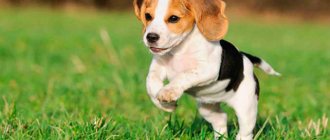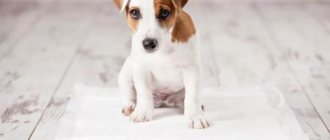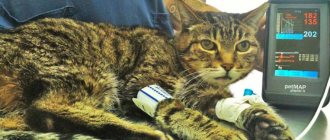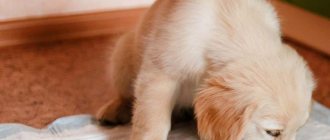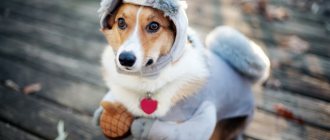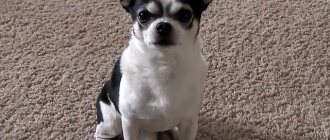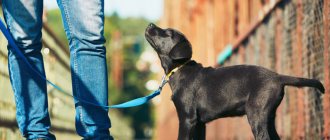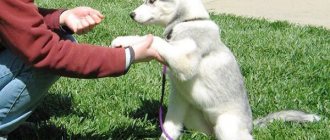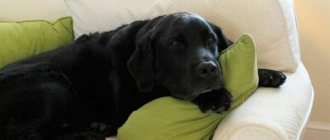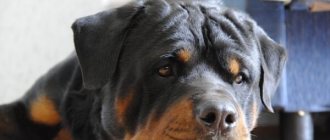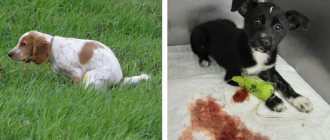The puppy often does not know how to control himself and leaves surprises, so the first priority is to train the dog to the toilet. This is a long and painstaking process that requires patience and calm, because a frightened pet is much more difficult to control and train.
- 1 Ideal age for toilet training
- 2 How to train a dog to toilet outside depending on age 2.1 Puppies
- 2.2 Adult dogs
Ideal age for toilet training
At each age, a dog is toilet trained differently. It is important to take into account all the characteristics of your pet and find the optimal approach. Let's look at the factors that influence a dog's learning ability:
- Age. Young animals perceive information much easier, learn the basics and are more flexible.
- Origin (where the animal was taken from: nursery, from the street, from the village). It leaves a strong imprint on its behavior, and the older the animal, the more difficult it is to straighten and train it. A dog that has lived in a kennel on the street most of its life will have a hard time getting used to the fact that it has to endure and beg.
- Basic education. Knowledge of basic commands implies, albeit minimal, discipline. It will be easier to find a common language with such a pet, regardless of age.
- Character. Innate temperament is important. Calm and attentive dogs perceive lessons more easily and are observant. Cheerful fidgets will be more absent-minded. Their attention needs to be attracted, first taught to hear the owner, and this is not an easy task, which can only be solved using the game method.
If we talk about at what age it is better to toilet train a dog, then there is no clear answer. Veterinarians believe that 4-6 months is the optimal time when the animal begins to compare actions and desires. During this period, all internal organs are fully formed, and the dog can easily endure the night without harm to health.
The preparation stage is important, so you should pay special attention to it. If your dog goes to the toilet every other time, don’t despair; the animal needs time to adapt. It is important that there is already an understanding of what is possible and what is not.
During the first months of a dog’s life in the house, the owner will have to watch the puppy, literally predicting its actions, in order to take it outside in advance. You may have to do walks 10-12 times daily and 3-4 times a night, but this will give results. The dog will understand that you can only go to the toilet outside.
First steps when bringing a pet into your home
As soon as a new four-legged tenant appears in your home, you need to immediately, without delay, begin toilet training your dog. In this case, it is not enough to put a tray and poke the puppy’s nose there. Preparation includes a whole series of events:
- Observation - a dog, even a small and still stupid one, when choosing a place for the toilet, is guided by certain rules and instincts. To begin with, it is better to use them to your advantage and “follow the lead” by organizing a toilet in the place that for some reason the dog liked.
- “Clearing” the territory - for the first time it is best to remove all carpets and paths, since small puppies most often choose them as a latrine. If the dog has chosen the bathroom for its needs, provide it with free access.
- Placement of toilets - it is quite possible that the puppy will choose not one, but several places at once. One of the fairly effective training methods is to install several trays. This is necessary because the little fidget does not always have time to run to the tray, which is why it begins to settle down in the corner closest to the place of play or sleep. In the future, as the animal grows, the number of trays can be reduced to 1 or 2. The second one will play the role of a spare one, since many adult individuals, during a period of long absence of their owners, simply do not want to go to a dirty, uncleaned toilet and choose a new place.
How to train a dog to toilet outside depending on age
You need to teach a puppy and an adult dog to go to the toilet differently. Let's look at the basic techniques recommended by breeders and veterinarians.
Puppies
Young dogs are easy to train; it is important that the owner does not shout or scold the pet.
- When starting classes, you should set aside a few free days without leaving home. This could be weekends or holidays.
- Prepare a special treat for your pet to take with you on walks. Ideal - favorite cookies or dry treats for dogs.
- As you watch your puppy throughout the day, be prepared to go outside with him at any moment if you notice him getting ready to go to the toilet.
- When choosing a walking location, they give preference to quiet streets or parks, where there are few people and cars, away from playgrounds.
- If your dog is walking on a leash, you should give him maximum freedom of action. There is no need to pull or call out to him.
- As soon as the pet performs its natural needs, they praise it and treat it with goodies.
- You should not go home immediately after bowel movement. You can take another walk, perhaps the animal will go to the toilet again. Be sure to reward the dog every time he goes outside and not give him treats in the house. This will be a kind of incentive.
For several days, this ritual should be repeated from time to time, maybe 7 or 10 walks. Every exit, the result will be recorded in the dog’s head, developing a habit.
Owners should remember:
- A dog that wets itself from joy at the sight of its owner should not be punished. This only happens to young animals.
- A puppy's metabolism is much faster, so you don't need to wait long between walks. You must constantly monitor your pet’s actions during the learning process.
- Puppies under 4 months are unable to endure for long, so you should not start training the animal too early.
Adult dogs
If before moving into an apartment the pet lived on the street, then training will be difficult, you should be patient. In cases where a toilet-trained dog changes its owner and place of residence, problems may arise. This is a temporary phenomenon associated with the adaptation process. You can scold such a dog, but you don’t need to punish him.
Adult animals can endure for quite a long time, but you should not abuse their capabilities. There is no step-by-step learning process for them; there is a general set of rules, guided by which the owner can influence the behavior of the pet:
- If there are visible signs of a desire to go to the toilet, the pet is immediately taken outside. For encouragement, take a treat with you.
- For punishment, it is better to use a newspaper; the owner’s hand should not bring anything but goodies and affection. There is no need to apply force when hitting, the dog should not be in pain, it is simply clear that he did the wrong thing.
- If an adult animal is caught in the process, it is necessary to prevent completion, take what the dog has done outside and wait for it to finish outside the house.
- The place where the animal went is treated with special means to prevent the need to go again.
It is impossible to say unequivocally how long it will take to retrain. It all depends on the dog’s temperament, the former and current owner and a number of related factors. In any case, kindness and patience will be needed.
Preparing for training
First, some tips for owners:
- Be patient. No matter how smart a dog is, it will take time for it to understand what you want from it and learn to tolerate it until the street. Be prepared in advance that the learning process may not be too fast;
- Make a feeding plan (preferably with your veterinarian). Determine the optimal portion size and how many feedings per day are needed. Give meals on a schedule and do not allow your dog to eat between scheduled meals. Puppies have very fast metabolisms, and the more often they eat, the more often you will need to go out;
- Prepare in advance a particularly tasty treat that you will use to reward your dog for doing things outside. Keep treats near the front door so you can quickly grab them when you go out with your puppy. Treats should be small (about the size of a fingernail). For each trip to the toilet - 3-5 pieces;
It is best to start training on vacation or at least on weekends - you should be at home all day and be able to take the puppy out many times. And once you start training, don’t quit halfway.
How to toilet train a dog using a diaper
The method of training a dog to walk on a diaper at home bears fruit after reaching the appropriate age for training. It is not difficult to teach an animal to defecate on a rag. After soaking the fabric in the puddle made by the puppy, it is washed, but the smell remains. The bedding is placed on the floor, and next time the dog will go to the same place.
When the dog reaches the right age, the owner can easily teach it to relieve itself on the street using the same rag. When going out for a walk, they take the diaper with them, spread it in a quiet place, and the dog always goes to the toilet out of habit. Next, using the method for puppies, take the dog to the same place with a cloth over and over again; after 2-3 days the cloth will not be needed, since a characteristic smell will remain on the ground.
When cleaning up after your dog at home, you should not use ammonia-containing preparations, for example, Domestos. These means, on the contrary, attract the animal to defecate right there. Chlorine bleach affects the respiratory tract, so store-bought pet sprays are best for cleaning stained areas.
The process of cleaning up feces should only begin after the pet has left. If he doesn’t want to, then they send the dog away. You can’t clean the floor in front of your pet; he may perceive it as a game and start shitting all over the place.
Screaming and punishment are unacceptable when working with puppies. Frightened, they begin to hide and it will be impossible to observe them for later taking them outside.
At what age do you start training?
How to toilet train a Chihuahua: diaper or litter box
You can teach your pet to go to the toilet rather than relieve itself on the floor at an early age. The older the dog, the more difficult it is to train.
The animal's tray must be made of hypoallergenic material.
Puppies less than a month old are also practically impossible to train. Babies under 3 months often cannot control urination. For this reason, litter box training will be most effective once they reach 4-5 months of age.
How to train a small dog to use a litter tray
Owners of small breeds can easily teach their pet to go to the litter box. The same result can be achieved from larger animals in puppyhood. In any case, until all required vaccinations are completed, you cannot take the dog outside. All this time, the animal defecates anywhere, so experienced owners begin the learning process right away.
Scolding and punishment are not helpful in this matter, so be patient and start by installing a tray with pieces of paper for small breeds; for large breeds, lay down oilcloth.
When observing an animal, you can see when you need to take it to the toilet. Restless movements, frequent sniffing of the floor, aimless walking around the house - all these are signs of the desire to defecate. The dog is picked up and carried to the tray over and over again. If you fail to go to the toilet where you need to go on your first try, don’t despair. For example, a pet made a puddle not where expected. They take the paper, clean up after the animal and carry the material saturated with the smell to the tray. Next time the animal will navigate by smell. After the dog goes into the tray for the first time, the paper can be removed.
Features of training different breeds
The training technique is the same for everyone, but sometimes it is necessary to take into account some breed characteristics. The owners will have to master these nuances:
- Yorkshire Terriers. Yorkies are initially limited in their free space. Otherwise, training will be greatly delayed. Cover a small enclosure with diapers and equip it with everything you need.
- Husky. Puppies of this breed take a long time to learn on their own. They are raised by their mother until they are six months old. With earlier weaning, all worries are assigned to the owner. Breeders recommend accustoming them to newspaper, since otherwise any soft surface will be affected.
- Toy terriers and chihuahuas. The accelerated metabolism of these dogs results in frequent urination. They will have to be placed on the litter after each feeding. If you wet it a little with warm water, your pet’s urination reflex will work. Pets are good at capturing their owner’s mood, so they understand well what they want from them.
- Shpitsev. These curious dogs love to explore the world. You won't be able to keep them in the playpen, so stock up on reusable products that can cover most of your apartment.
- Labradors. Labradors are among the ten most intelligent dogs, quickly learn commands and understand their owner well. If you try to relieve yourself in the wrong place, say “No” or “Ugh”, pick up your pet and move it to the required place. If you succeed, don't forget about encouragement.
When purchasing a puppy, ask the breeder for your pet's personal diaper. Even a habituated animal gets lost in a new territory. A familiar smell will guide you in the right direction and prevent mistakes.
How to train a dog to go to the toilet outside
A puppy, like a child, needs care and attention. Timed feedings, regular clinic visits, and vaccinations are necessary initial steps. It is also important to understand that dogs, unlike cats, endure separation from their mother more difficult, so you need to pay attention to them regularly.
During the vaccination period, the dog goes to the toilet, anywhere in the house or to the litter tray, it depends on the patience of the owner. Regardless of the location of the bowel movement, wet cleaning of the house should be carried out twice a day. The place where the dog goes is cleaned immediately after defecation is completed.
When the animal is completely ready for walks, and preventive measures have been completed, they begin to teach the dog to go to the toilet outside. This usually happens at 3-4 months.
Observation of animals has shown that with proper metabolism, acts of defecation most often occur 10 minutes after eating and immediately after sleep. Try to be outside during these moments. It is not necessary to carry a sleepy animal into the yard in your arms; immediately after waking up, they begin getting ready for walking.
Young dogs need to be walked frequently, every 2-3 hours. An accelerated metabolism causes the desire to defecate much more often than in adult dogs. As you get used to it, the number of walks can be reduced.
Be sure to reward the animal for mastering the skill. At first, every right deed should be marked with a kind word and delicious food.
Having trained your pet to go to the toilet in the same area, begin to gradually change routes so that the dog explores new places and gets acquainted with the world around him.
After this, you can begin training behavior in the house. For example, if a dog is about to relieve itself in an apartment, the owner should use short prohibitory commands (“Fu”, “No”) and light punishment in case of disobedience.
Teaching a dog to go to the toilet outside is not difficult, it takes time. Just a week of attention from the owner and the dog will learn to behave correctly.
What to do before accustoming your puppy to a diaper or tray
Buy a diaper or tray in advance
There are two types of diapers: disposable and reusable. The bottom layer of the former consists of polyethylene, which does not allow moisture to pass through, the top layer is made of fabric resembling cotton wool. This product is thrown away after several uses. The average cost of a package of 10 pieces is 150 rubles. They are sold in pet stores, pharmacies, supermarkets and online platforms.
Keep in mind: the puppy may start playing and tear the disposable diaper into small pieces. This behavior will have to be stopped.
Reusable diapers also consist of several layers. The upper one is made of fabric that allows moisture to pass through and dries quickly. Next, a fabric is sewn in to absorb and hold a large volume of liquid. The lower part of the product is a waterproof membrane. After several uses, the diaper is washed, so there should be at least one more in stock. Products are sold in pet stores. The cost starts from 250 rubles.
If it is expected that the dog will relieve itself at home all the time, you can buy a tray for the diaper. This is a plastic container with small sides. The bedding is placed under the frame and fixed tightly. There are structures with columns or walls. These are usually taken for males.
Pet stores also sell trays with imitation lawn. As a rule, these are three-level structures. The top tier is artificial realistic grass, the middle tier is a lattice that allows liquid to pass through, the bottom tier is a container where urine accumulates. Such products are thoroughly washed under water.
The dimensions of the diapers and trays depend on how big the puppy is. For example, products measuring approximately 40 × 60 cm are suitable for dwarf breeds, and 60 × 60 or 60 × 80 for medium breeds.
What to buy
- Disposable absorbent diapers from “Clean Tail”, 30 pcs, 313 rubles →
- Reusable absorbent diaper from OSSO Fashion, 840 rubles →
- Toilet with sides and column from Homepet, 1,112 rubles →
- Toilet with sides from SAVIC, 1,540 rubles →
- Toilet with imitation lawn from Pet Park Potty Patch, 3,240 rubles →
- Toilet with a wall from ZooOne, 1,864 rubles →
Stock up on cleaning supplies
The puppy will not immediately learn to hit the diaper accurately. Therefore, it is better to prepare hand gloves, rags or paper towels, and cleaner in advance. The latter should not contain ammonia. This compound is found in animal urine. If you add the substance to the contaminated area, the smell will become even stronger. It is better to stock up on baking soda, vinegar or odor remover.
What to buy
- Hand gloves from Vileda, 379 rubles →
- Three viscose cleaning napkins from Celesta, 46 rubles →
- Spray-eliminator of animal odors Iv San Bernard, 1,200 rubles →
Prepare the house
Remove carpets, shoes, bags and other items from the floor. The dog may confuse them with a diaper or tray. If there is carpet in any of the rooms, it is better to temporarily not let the animal there. Wait until the dog learns to control his urges and relieve himself in the designated area.
Mr. Tail recommends: problems of adult dogs
Adult animals have a harder time relearning, but they can endure it much longer. This is worth taking into account, and if you have to make concessions with kids, using diapers and trays, then allowing an adult dog to go home once provokes him to constantly use the comfortable opportunity. Why endure it when you can go to a corner in the apartment.
If mistakes happen occasionally, it is recommended to reconsider the walking and feeding schedule; perhaps the dog cannot tolerate it due to irrational time management.
Often, owners of small breeds, such as Yorkies and Chihuahuas, are themselves to blame for the fact that the animals shamelessly shit everywhere. Lack of punishment and education in dogs is not uncommon. Such lapses can be corrected by mustering willpower and starting with light punishments for violations and praise for correct behavior. It is important to remember that animals are very smart and are excellent at manipulating their owner’s feelings; they should not be allowed to do this.
If a dog begins to commit outrages for no apparent reason, you should pay attention to his state of health. Contact your veterinarian. If the doctor considers the pet healthy, it makes sense to talk with members of the household; it happens that someone offends the animal, scolds or punishes, creating a stressful situation in which the dog behaves inappropriately. Such disorders are treated with care and attention, as well as a serious conversation with the person who provoked such circumstances.
Common problems and their solutions
No. 1. Puppy keeps peeing at home or defecating in crate
- If training does not bear fruit, most likely you are not training your pet hard enough, you have set the schedule incorrectly, and you cannot catch the moment when you need to go out. Adjust basic aspects of training and consult your veterinarian if necessary.
- If the puppy is toileting in the crate, it is likely too large and the dog has the opportunity to create a “bedroom” and a “sanitary area” for himself. The optimal size is such that the animal can lie, stand and sit freely. If the area has nothing to do with it, it’s worth going to see a veterinarian. Perhaps the puppy was previously crated for too long and had no choice but to misuse the space provided. This behavior requires correction, but it can be difficult to do this without a specialist. In addition, the desire to roll in one's own excrement and other atypical habits may be associated with certain diseases.
No. 2. You can't catch the moment when you have to go outside
- Stay close to your puppy at all times. Temporarily limit his movement around the apartment so that he is in the same room with you - close the doors, place special gates in the openings.
- If you still can't, use a cage. But in moderation!
No. 3. The puppy does not want to pee outside; he walks and plays instead of satisfying sanitary needs
- Some owners o. Wait at least 10 minutes and do not distract the puppy with anything. If nothing happens, return home and try again in another 10-15 minutes. Sometimes a third try is required.
- Check that the leash is 2 m long.
- Often the puppy does not go to the toilet because the owner distracts him - he switches the animal’s attention to himself. To avoid getting in the way, just wander back and forth. Don't talk to the dog or try to play.
- Make sure your four-legged friend has no other distractions - toys, other dogs.
Arrangement and selection of location
The successful choice of a place in the house for the dog toilet and its arrangement play a very important role in teaching the pet to do its business in the designated place.
The following dog breeds are suitable for keeping in the house: Chihuahua, Basset Hound, Biewer York, Miniature Poodle, Welsh Corgi, German Spitz, Maltese, Maltipoo, Pomeranian.
Selecting a tray
Before you start toilet training your puppy, the first thing you need to do is choose a litter tray. We will look at how to do this below.
The range of dog potties in pet stores is very wide, so everyone can choose the most suitable option for their pet. Such trays are made from two types of materials:
- Galvanization.
- Plastic.
Externally, they look like a tray, in the inner part of which there is a grate or a special mat.
The size range also has a lot of options, and you need to choose based on the individual parameters of a particular dog. If the dog is a small breed, then it is better to give preference to a tray with low sides.
Well, and accordingly for large breeds - with tall ones. However, keep in mind that dogs do not tolerate cramped conditions, so it is better to give preference to a slightly larger tray than a smaller one.
Important! Don't buy cat litter boxes: they are completely different from dog litter boxes and are absolutely not suitable.
There are even special trays for male dogs, equipped with a post. This will allow your pet to cope with its need to leave marks and will protect the walls in the apartment from them.
You should definitely know which commands are best to start training with and how to turn the complex training process into an interesting game for both parties.
Today, weed toilets are becoming increasingly popular. This option imitates natural conditions, and it is easier for the puppy to get accustomed to such a tray. If there is a person in the house who suffers from allergies, then you definitely need to buy a tray with fixation. This option will help secure the diaper and thus prevent the spread of unpleasant odors throughout the house, and of course, it absorbs liquid well.
Preparing the filler
Pet stores sell special litter for dog litter. However, the litter trays we are accustomed to are not quite a dog option, since they do not, like cats, have the reflex to bury their feces. Therefore, it will be enough to pour a thin layer of filler onto the bottom of the tray.
Many dogs do not recognize such toilets and prefer to do their business using the newspaper. In this case, you should simply tear the newspaper or even put a whole sheet of it on the bottom of the tray. But at the same time, you need to replace it on time, because dogs do not like to go to the wet toilet. A more practical, but also more expensive option is to place a moisture-absorbing diaper on the bottom of the tray.
Toilet space
It is better to choose a place reserved for the dog toilet in a quiet and peaceful corner. But when choosing a place, it is also important to take into account the characteristics of dogs. The tray must be placed in your pet’s favorite area. Therefore, the most suitable option for placing the tray would be a place near the door leading to the street, on the loggia or next to the window. If the puppy continues to persistently mark one place, then try placing the tray there.
Important! If you need to wean your puppy from his chosen place for the toilet, then place his dishes with food and drink there - the dog will never do his business in a place intended for food.
Training process
The stages of litter box training coincide with diaper training. And if you plan to train your dog to use the litter box on an ongoing basis, start doing this right away. However, small breed puppies may have difficulty getting into the tray if its walls are too high, in which case you will first be trained to a regular diaper and only then purchase a litter box.
At first, you will need to place the usual bedding in the tray; it can be removed only when the dog begins to confidently use the tray.
The dog toilet should be located according to the same principles as indicated above.
We advise you to read: When does a puppy open its eyes?
